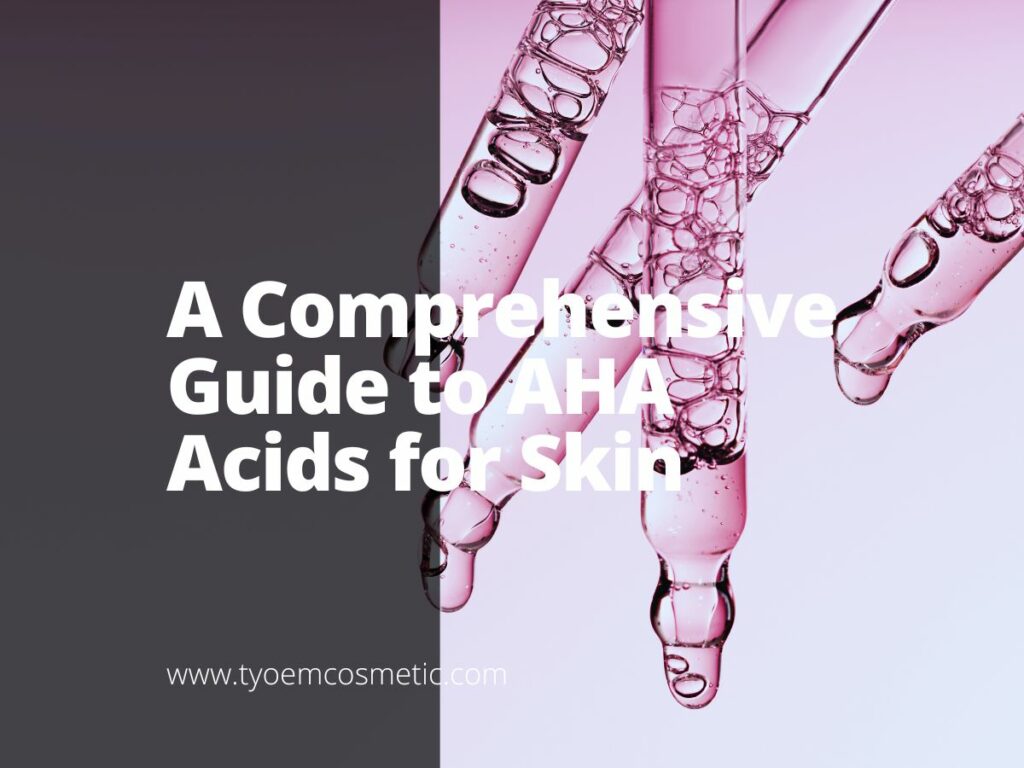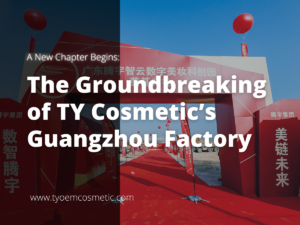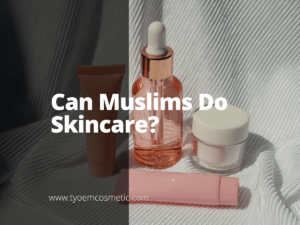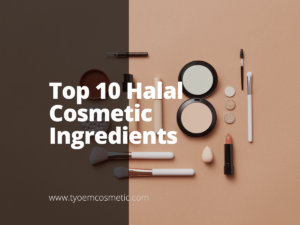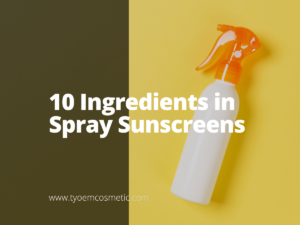Are you fully utilizing the potential of AHA acids in your skincare formulations? These highly effective ingredients, known as alpha-hydroxy acids, are revolutionizing skin care routines.
Our insights are grounded in the latest dermatological research, providing you with trustworthy and up-to-date information on AHA acids essential for any brand.
AHA acids offer an exceptional balance of efficacy and gentleness, making them a key component in modern skincare solutions.
In this guide, we dive into the science, benefits, and practical applications of AHA acids, equipping you with knowledge to transform skin health.
Keep reading to unlock the secrets of AHA acids.
1. Understanding AHA Acid
Alpha-hydroxy acids, commonly known as AHAs, are naturally occurring substances often sourced from fruits and milk. They are renowned for their ability to exfoliate the skin’s surface, promoting a more radiant and smoother complexion. AHAs work by loosening the bonds between dead skin cells, facilitating their removal and revealing the healthier skin beneath.
In skincare formulations, AHAs are well-known for their versatility and efficacy across different skin types. These acids are particularly effective in addressing concerns like uneven skin tone, fine lines, and textural irregularities. Their water-soluble nature ensures that they are gentle on the skin, making them a suitable choice for a broad range of skincare routines.
2. Benefits of AHA Acids for Skin
AHA acid offers many essential benefits for the skin essential for enhancing the skincare routine with effective and proven ingredients. Here are the key advantages of incorporating AHAs into skincare products:
- Exfoliation: AHAs are known for their exfoliating properties. They work by gently dissolving the bonds that hold dull, dead skin cells on the skin’s surface. This action reveals a fresher, smoother complexion, making them a key ingredient for achieving radiant skin.
- Hydration: Beyond their surface-level exfoliation, AHAs are known for enhancing skin hydration. They attract moisture to the skin, helping to combat dryness and promote a softer and fuller appearance. This hydration boost is especially beneficial for those with dry or mature skin.
- Anti-Aging: AHAs play a significant role in anti-aging skincare routines. They help reduce the appearance of fine lines and wrinkles by promoting collagen production and improving skin texture. Regular use of AHA-infused products can lead to firmer, more youthful-looking skin over time.
- Complexion Enhancement: AHAs are effective in improving overall skin tone and texture. They work on reducing the appearance of dark spots and hyperpigmentation, leading to a more even and bright complexion. This makes them an excellent choice for those looking to diminish age spots and sun-induced discoloration.
3. Types of AHA Acids and Their Unique Properties
Each type of AHA acid offers unique benefits, tailored to address specific skin concerns and enhance overall skin health. To understand their individual strengths and applications, here’s a detailed exploration:
Glycolic Acid
Glycolic acid, extracted from sugar cane, is known for its small molecular size, allowing deep skin penetration. It is especially effective in rejuvenating aging skin, targeting fine lines, acne, and uneven skin tone. Its exfoliating capabilities are among the strongest of the AHAs, making it a top choice for achieving a brighter, more youthful complexion. This acid is ideal for those seeking significant exfoliation and skin renewal.

Lactic Acid
Lactic acid, derived from milk, is celebrated for its gentle nature and hydrating qualities, making it a perfect match for sensitive and dry skin. It works effectively to soften and smooth the skin, improving texture and reducing pigmentation issues. Besides exfoliation, it enhances moisture retention, contributing to a fuller, more radiant skin appearance. It is a preferred choice for those aiming for hydration and gentle exfoliation.

Citric Acid
Citric acid, sourced from citrus fruits, excels in unclogging pores and mitigating sun damage, making it a key component in anti-aging formulations. Its ability to even out skin tone and promote a balanced complexion is highly valued. This acid offers a well-rounded approach to skincare, combining exfoliation with brightening effects. It is often chosen for its versatility in treating various skin concerns, particularly related to aging.

Malic Acid
Malic acid, found in apples, offers a unique blend of exfoliating and hydrating properties, improving skin elasticity and combating sun damage. Its milder nature makes it less likely to irritate, ideal for those with sensitive skin types. Its balanced approach aids in smoothing skin texture and enhancing overall skin health. It is an effective ingredient for those seeking a gentle yet effective AHA experience.

Tartaric Acid
Tartaric acid, from grapes, is particularly beneficial for acne-prone skin due to its ability to reduce the appearance of pores and assist in exfoliation. It helps manage skin texture issues and is effective in preventing pore blockage. This acid’s properties make it a vital component in skincare products aimed at achieving a clearer, more refined complexion.

4. Potential Side Effects of AHA Acid
While AHA acids are generally safe and beneficial for skin health, they can have potential side effects, especially if not used correctly. Here are some common concerns to be aware of:
Irritation and Redness
AHA acids can cause skin irritation and redness, particularly for those with sensitive skin or when used in high concentrations. This is due to their ability to disrupt the skin’s protective barrier. Symptoms can include a stinging sensation, itching, and visible redness. TY Cosmetic’s carefully formulated products are designed to optimize the benefits of AHAs while minimizing potential irritation, ensuring comfort for all skin types.
Sun Sensitivity
While effective for exfoliation, AHAs increase skin’s sun sensitivity, raising the risk of sunburn and long-term damage, including premature aging and an elevated risk of skin cancer. Daily use of high SPF sunscreen is essential when using AHAs, even on cloudy days. Wearing hats and protective clothing can provide additional protection.
Dryness and Peeling
AHAs, by promoting the shedding of the skin’s outer layer, can lead to dryness and peeling, especially if used excessively or in high concentrations. This side effect is due to the loss of the natural oils and moisture that are stripped away along with the dead skin cells. Symptoms include flaky skin, tightness, and possible itching. To counteract this, it’s important to use hydrating skincare products and to limit AHA use until the skin adjusts.
Allergic Reactions
Though rare, AHAs can cause allergic reactions in some individuals, characterized by symptoms like itching, redness, swelling, or the formation of a rash. These reactions occur when the immune system identifies AHAs as harmful, triggering a response. Perform a patch test before using AHA products in the skincare routine and if an allergic reaction is observed, stop using the product and consult a dermatologist.
pH Imbalance
Improperly balanced AHA products can disrupt the skin’s natural pH, leading to a range of skin issues. The skin’s pH is crucial for maintaining its barrier function and overall health. An imbalanced pH can result in increased dryness, irritation, and a higher risk of infections. It’s important to choose AHA products that are formulated to maintain pH balance to avoid these complications.
5. Common Myths About AHA Acids
There are many misconceptions about AHA acids, often leading to confusion in their application. Here are key myths clarified to reveal the facts:
AHA Acids Thin the Skin
The belief that AHAs thin the skin is a common misconception. In reality, AHAs work by gently exfoliating the outermost layer of dead skin cells, promoting healthier, more resilient skin underneath. This process can actually improve skin thickness over time by stimulating collagen production. It’s crucial to understand that AHAs do not damage or weaken the skin’s structure; instead, they help in its rejuvenation and strengthening.
AHA Acids are Only for Aging Skin
Contrary to the belief that AHAs are solely for aging skin, these acids offer benefits for a wide range of skin types and concerns. They help in improving overall skin texture, reducing acne, and achieving a more even skin tone. Their exfoliating properties make them suitable for younger skin that might be prone to acne or dullness. Thus, they are a versatile ingredient beneficial for various ages and skin concerns.
Here’s a table that dispels the misconception that Alpha Hydroxy Acids (AHAs) are only for aging skin, highlighting their benefits for various skin types and concerns:
| Aspect | Description | Benefits for Different Skin Types |
| Skin Texture Improvement | AHAs help in exfoliating the skin, removing dead skin cells. | Results in smoother, more refined skin texture, beneficial for all ages. |
| Acne Reduction | Effective in unclogging pores and reducing acne breakouts. | Particularly suitable for younger skin prone to acne. |
| Even Skin Tone | Aids in diminishing hyperpigmentation and uneven skin tone. | Helps in achieving a more uniform complexion, regardless of age. |
| Exfoliating Properties | AHAs are known for their exfoliating abilities. | Useful for combating dullness and revitalizing the skin’s appearance. |
| Versatility | Suitable for a wide range of skin types and concerns. | Not limited to aging skin; beneficial for various ages and skincare needs. |
Immediate Results Are Guaranteed
Expecting immediate results from AHA use is a misconception. While they are effective in skin rejuvenation and improvement, their benefits are seen over time with consistent use. Initially, they work at a cellular level to accelerate cell turnover and remove dead skin cells, which don’t happen overnight. Patience and regular application are key, as visible improvements in skin texture and tone develop gradually.
AHA Acids are Harmful Chemicals
The characterization of AHAs as harmful chemicals is a misunderstanding of their nature and role in skincare. They are often derived from natural sources like fruits that are carefully formulated for safe use on the skin. They are extensively researched and proven to be beneficial when used correctly. It’s important to remember that, like any skincare ingredient, they should be used as directed to avoid over-exfoliation or irritation.
AHA Acids Can Replace Moisturizers
While AHAs do have hydrating properties, they primarily function as exfoliants. Moisturizers, on the other hand, are designed to hydrate and lock in moisture, a crucial step especially after using AHAs, which can increase skin’s sensitivity and potential for dryness. Therefore, a balanced skincare routine should include both AHAs for exfoliation and moisturizers for hydration.
6. 5 Tips for Choosing the Right AHA Product
As per Global Market Insights, the AHA market surged in 2021 and is set to continue rising through 2028, driven by increased usage in hair care products. Here are key tips to bear in mind when choosing AHA product:
#1 Understanding Skin Type
When selecting an AHA product, it’s crucial to consider the skin type. For example, for sensitive skin, milder AHAs like lactic acid are recommended to minimize irritation, whereas more resilient skin may benefit from stronger acids like glycolic acid. It’s essential to understand the skin’s needs and reactions to different types of acids. This knowledge helps in choosing a product that is effective yet gentle enough to avoid adverse reactions.
#2 Concentration Matters
Beginners should start with lower concentrations, such as products containing 5-10% AHA, to allow the skin to adjust without causing irritation. As the skin becomes accustomed to AHAs, gradually move to higher concentrations to achieve more noticeable results. Remember, higher doesn’t always mean better; it’s about finding the right balance for your skin.
#3 pH Levels
The pH level of AHA products plays a significant role in their effectiveness and safety. AHAs are most effective in formulations with a pH between 3 and 4, as this range ensures the acid’s potency without causing harm to the skin. Avoid products with a too low pH, which can be overly harsh, or too high, which can render the AHA ineffective. A well-balanced pH is crucial for the best results while maintaining skin health.
#4 Combination with Other Ingredients
Combining AHAs with other skin-nurturing ingredients can optimize skin benefits and reduce potential irritation. For instance, look for formulations that include hydrating elements like hyaluronic acid or soothing components such as aloe vera. These combinations can enhance the positive effects of AHAs while providing additional skin care benefits. It’s a collaborative approach that targets multiple skin concerns effectively and gently.
#5 Packaging and Preservation
Packaging of AHA products is vital for preserving their effectiveness. They are sensitive to light and air, so opt for products in opaque, air-tight containers to ensure stability and efficacy over time. Additionally, proper packaging helps in maintaining the product’s purity and prevents contamination. TY Cosmetic prioritizes advanced packaging technology to safeguard the integrity and effectiveness of the AHA formulations.
Dive Deeper Into Our Resources
Interested in discovering more? Gain instant access to our diverse range of products:
For some insightful reads, we’ve curated a list of recommended articles just for you:
- Skincare Formulas: What You Need to Know
- Body Care Business: Navigating Success in the Wellness Industry
Still haven’t found what you’re looking for? Don’t hesitate to contact us. We’re available around the clock to assist you.
Conclusion
Diving into the world of AHA acids unveils exciting possibilities for achieving excellent skin. This guide has provided a comprehensive exploration of these transformative skincare ingredients helping you better understand and use them to enhance your skincare products.
If you aim to elevate your skincare formulations by incorporating the remarkable power of AHA acids, TY Cosmetic is your perfect ally. Contact us today for customized advice and further insights.


